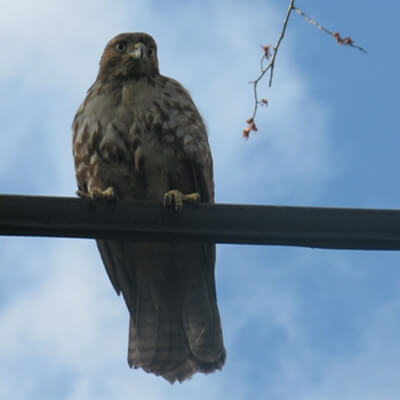News
A hawk balancing on an electrical wire. (Photo courtesy of Fawwaz Habbal, SEAS.)
While hawks have traditionally found a home in a pine tree near Pierce Hall at the Harvard School of Engineering and Applied Sciences (SEAS), a nesting pair of hawks has decided to switch venues for 2011.
The birds constructed a nest atop Maxwell Dworkin, using the building's iconic curtain wall for support.
A team of SEAS staff members—Eliza Grinnell in communications; Lesley Lam in IT; and Don Claflin and Phil Kenneally in facilities—worked together to deploy the camera.
Particular credit goes to Kenneally for making the "roof walk" (two times, in fact) to place the webcam in an appropriate spot to zero in on the nest.
The feed is optimized for the Firefox and Safari web browsers, and viewers can tune in here: http://hawk.seas.harvard.edu/
Note: The camera can be temperamental and only supports a limited number of users at a time; viewers may need to try multiple browsers and/or reset and clear their cache before obtaining a live feed. We are working to improve performance!
The hawks, long a source of a fascination on the north end of the Harvard campus, have evoked a variety of responses at SEAS.
Cherry A. Murray, Dean, asked: "Is this the SEAS mascot?"
Fawwaz Habbal, Executive Dean, has been trailing the hawks for some time, using a digital camera to record sightings (his photos are to the right).
And Rosalyn "Ros" Reid, Assistant Dean for External Affairs and Executive Director of the Institute for Applied Computational Science, offered some insights and a bit of a warning to potential nature watchers.
"I've been told that the mating pair at MD has a bit of a reputation as campus predators (assuming they're the same pair that used to nest in the tree on the south lawn, which they probably are)," she said.
"That is to say, they have a habit of swooping down, grabbing squirrels and publicly ripping them apart, as raptors are wont to do. They also used to noisily conduct their, um, mating activities, on the light fixture outside [faculty member] Rob Howe's office [in Pierce 323]."
Related articles on "wildlife" at Harvard
Cutting-edge science delivered direct to your inbox.
Join the Harvard SEAS mailing list.
